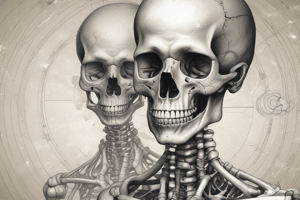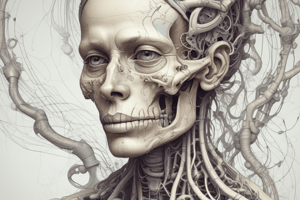Podcast
Questions and Answers
What is the primary source of vitamin D for the body?
What is the primary source of vitamin D for the body?
- Dietary supplements
- Intravenous injections
- Fortified foods
- Skin exposure to sunlight (correct)
Which laboratory finding is associated with osteomalacia due to low vitamin D in adults?
Which laboratory finding is associated with osteomalacia due to low vitamin D in adults?
- Decreased serum phosphate
- Decreased PTH levels
- Increased serum calcium
- Increased alkaline phosphatase (correct)
Which of the following clinical features is NOT associated with rickets in children?
Which of the following clinical features is NOT associated with rickets in children?
- Pigeon-breast deformity
- Rachitic rosary
- Frontal bossing
- Joint hypermobility (correct)
What is the most significant factor influencing peak bone mass?
What is the most significant factor influencing peak bone mass?
Which type of osteoporosis is most commonly seen in elderly individuals?
Which type of osteoporosis is most commonly seen in elderly individuals?
What effect does vitamin D have on the kidneys?
What effect does vitamin D have on the kidneys?
Which factor contributes to a more accelerated loss of bone mass after achieving peak bone mass?
Which factor contributes to a more accelerated loss of bone mass after achieving peak bone mass?
During what age is peak bone mass typically achieved?
During what age is peak bone mass typically achieved?
Which treatment is debatable and currently not recommended for Paget disease of bone?
Which treatment is debatable and currently not recommended for Paget disease of bone?
What is the most common cause of isolated elevated alkaline phosphatase in patients over 40 years old?
What is the most common cause of isolated elevated alkaline phosphatase in patients over 40 years old?
Which of the following statements about osteomyelitis is correct?
Which of the following statements about osteomyelitis is correct?
What is the characteristic histological finding in a biopsy of Paget disease?
What is the characteristic histological finding in a biopsy of Paget disease?
Which condition is NOT considered a complication of Paget disease of bone?
Which condition is NOT considered a complication of Paget disease of bone?
What is a known cause of avascular necrosis of the bone?
What is a known cause of avascular necrosis of the bone?
In osteomyelitis, a lytic focus surrounded by bone sclerosis is referred to as what?
In osteomyelitis, a lytic focus surrounded by bone sclerosis is referred to as what?
What clinical feature is commonly associated with Paget disease of bone?
What clinical feature is commonly associated with Paget disease of bone?
What is the primary cause of achondroplasia?
What is the primary cause of achondroplasia?
In osteogenesis imperfecta, which of the following clinical features is NOT typically present?
In osteogenesis imperfecta, which of the following clinical features is NOT typically present?
Which mechanism defines endochondral bone formation?
Which mechanism defines endochondral bone formation?
What is the consequence of poor osteoclast function in osteopetrosis?
What is the consequence of poor osteoclast function in osteopetrosis?
Which condition is characterized by defective mineralization of osteoid?
Which condition is characterized by defective mineralization of osteoid?
What genetic mutation can lead to renal tubular acidosis in osteopetrosis?
What genetic mutation can lead to renal tubular acidosis in osteopetrosis?
Which feature is characteristic of achondroplasia?
Which feature is characteristic of achondroplasia?
What is the primary treatment for osteopetrosis?
What is the primary treatment for osteopetrosis?
Flashcards
Achondroplasia
Achondroplasia
A genetic condition characterized by impaired cartilage growth in the growth plates, resulting in disproportionately short limbs.
FGFR3 Mutation
FGFR3 Mutation
An activating mutation in the fibroblast growth factor receptor 3 (FGFR3) gene is the primary cause of achondroplasia.
Osteogenesis Imperfecta
Osteogenesis Imperfecta
A group of inherited disorders characterized by brittle bones that fracture easily.
Collagen Type I Deficiency
Collagen Type I Deficiency
Signup and view all the flashcards
Osteopetrosis
Osteopetrosis
Signup and view all the flashcards
Osteoclast Dysfunction
Osteoclast Dysfunction
Signup and view all the flashcards
Rickets (in children) or Osteomalacia (in adults)
Rickets (in children) or Osteomalacia (in adults)
Signup and view all the flashcards
Vitamin D Deficiency
Vitamin D Deficiency
Signup and view all the flashcards
Rickets
Rickets
Signup and view all the flashcards
Osteomalacia
Osteomalacia
Signup and view all the flashcards
Parathyroid Hormone (PTH)
Parathyroid Hormone (PTH)
Signup and view all the flashcards
Peak Bone Mass
Peak Bone Mass
Signup and view all the flashcards
DEXA Scan
DEXA Scan
Signup and view all the flashcards
Bone Resorption
Bone Resorption
Signup and view all the flashcards
Kyphosis
Kyphosis
Signup and view all the flashcards
What is Paget disease?
What is Paget disease?
Signup and view all the flashcards
Explain the bone remodeling process in Paget disease.
Explain the bone remodeling process in Paget disease.
Signup and view all the flashcards
What is the typical age of onset for Paget disease?
What is the typical age of onset for Paget disease?
Signup and view all the flashcards
What is the suspected cause of Paget disease?
What is the suspected cause of Paget disease?
Signup and view all the flashcards
How widespread is the bony involvement in Paget disease?
How widespread is the bony involvement in Paget disease?
Signup and view all the flashcards
Describe the stages of Paget disease.
Describe the stages of Paget disease.
Signup and view all the flashcards
What are some common symptoms of Paget disease?
What are some common symptoms of Paget disease?
Signup and view all the flashcards
Which lab test is often elevated in Paget disease?
Which lab test is often elevated in Paget disease?
Signup and view all the flashcards
Study Notes
Achondroplasia
- A common cause of dwarfism, resulting from impaired cartilage proliferation in growth plates
- Due to an activating mutation in fibroblast growth factor receptor 3 (FGFR3)
- Autosomal dominant inheritance
- Overexpression of FGFR3 inhibits growth
- Most mutations are sporadic, but some are linked to increased paternal age
- Characterized by short extremities, but normal-sized head and chest
- Intramembranous bone formation unaffected; long bone growth via endochondral ossification impaired
- Intramembranous bone formation does not involve cartilage precursor and forms flat bones (e.g., skull)
- Mental function, lifespan, and fertility are normal
Osteogenesis Imperfecta
- Congenital disorder causing weak bones due to defects in collagen type I synthesis
- Autosomal dominant inheritance is most common
- Characterized by multiple fractures (can mimic child abuse but bruising is absent)
- Presence of blue sclera (thinning of sclera showing underlying choroidal veins)
- Often associated with hearing loss due to fragile middle ear bones
Osteopetrosis
- Inherited disorder affecting bone resorption, leading to abnormally thick, heavy bones prone to fracture
- Poor osteoclast function is the underlying cause
- Genetic variants impacting carbonic anhydrase II (a critical enzyme for bone resorption) can cause this condition
- Often characterized by bone fractures, anemia, thrombocytopenia, leukopenia, and extramedullary hematopoiesis
- Visual and auditory impairments can occur due to cranial nerve compression
- Symptoms can include hydrocephalus and renal tubular acidosis
- Treatment may include bone marrow transplant
Rickets/Osteomalacia
- Defective mineralization of osteoid (the bone matrix) leading to abnormal bone formation.
- Caused by vitamin D deficiency, impacting calcium and phosphate absorption.
- Vitamin D is produced in skin upon exposure to sunlight (primary source) and consumed through the diet;
- Active vitamin D increases calcium and phosphate reabsorption in kidney and absorption in intestines to strengthen bones. Deficiency leads to abnormal bone mineralization
- Symptoms in children (rickets) are often noticeable by 1 year of age and can include pigeon breast deformity, frontal bossing, rachitic rosary, bowing of the legs
- Symptoms in adults (osteomalacia) include weak bones that easily fracture
- Diagnosis may involve assessing serum calcium, serum phosphate, parathyroid hormone (PTH), and alkaline phosphatase levels
Osteoporosis
- Characterized by reduced trabecular bone mass, leading to porous bones and increased fracture risk
- Risk factors include genetic predisposition, diet, exercise, and menopause
- Peak bone mass is achieved typically by age 30, after which gradual bone loss occurs.
Paget's Disease of Bone
- Imbalance between osteoclast and osteoblast function affecting bone remodeling
- Resulting in unusually thick and brittle bone often localized in one or more areas of the skeleton.
- Characterized by microfractures causing bone pain, enlarged hat size, hearing loss, and potential for high-output cardiac failure
- Biopsy of affected bone will reveal a characteristic 'mosaic' pattern of lamellar bone.
- Treatable through calcitonin and bisphosphonates.
Avascular (Aseptic) Necrosis
- Ischemic necrosis of bone and marrow often due to reduced blood supply
- Associated with trauma or fracture, use of steroids, conditions like sickle cell anemia, and caisson disease
- Complications include osteoarthritis and fractures
Studying That Suits You
Use AI to generate personalized quizzes and flashcards to suit your learning preferences.
Related Documents
Description
Explore the genetic mechanisms and characteristics of Achondroplasia and Osteogenesis Imperfecta. This quiz delves into the inheritance patterns, physical features, and underlying causes of these conditions. Test your understanding of these important genetic disorders.




